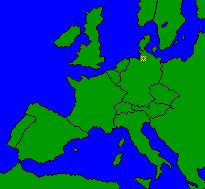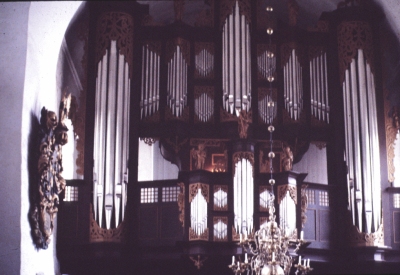  Stade: St. Cosmae |
|
In its complete form, the organ is a marvelous example of the Werkprinzip organ of late seventeenth-century Germany, and the defining characteristics described elsewhere in this tutorial can be found in its appearance as well as in its stoplist. |
| Oberwerk CDEFGA-c''' |
Rückpositiv CDEFGA-c''' |
Brustwerk CDEFGA-c''' |
Pedal CDE-d' |
|||||||
|---|---|---|---|---|---|---|---|---|---|---|
| Principal | 16 | Principal | 8 | Gedackt | 8 | Principal | 16 | |||
| Quintadena | 16 | Quintadena | 8 | Querflöt | 8 | Sub-Bass | 16 | |||
| Oktave | 8 | Oktav | 4 | Oktav | 2 | Oktav | 8 | |||
| Gedackt | 8 | Waltflöt | 2 | Tertia | 1 3/5 | Oktav | 4 | |||
| Oktave | 4 | Sieflöt | 1 1/3 | Nasat Quinte | 1 1/3 | Nachthorn | 1 | |||
| Rohrflöte | 4 | Sesquialter II | Sedetz | 1 | Mixtur V-VI | |||||
| Nasat | 2 2/3 | Scharff V | Scharff III | Posaune | 16 | |||||
| Oktav | 2 | Dulcian | 16 | Krumphorn | 8 | Dulcian | 16 | |||
| Mixtur VI | Trechter Regal | 8 | Schalmey | 4 | Trompete | 8 | ||||
| Cimbel III | Krumphorn | 8 | Cornet | 2 | ||||||
| Trompete | 16 | |||||||||
| Trompete | 8 | |||||||||
| Glockenspiel | ||||||||||
| Manual Coupler: Brustwerk to Hauptwerk Tremulant |
||||||||||
© 2000 James H. Cook
 Arp Schnitger's career as an organ-builder began in 1666 when he was apprenticed to his cousin Berend Huss, who was then engaged in building the organ for the church of St. Cosmae. The three manual divisions were completed in 1671, and under a separate contract Huss and his staff began work on the pedal division. Vincent Lübeck, who was organist there from 1675 until 1702, later asked Schnitger to make some modifications to the organ, and this work was completed in 1688. Since then the organ has suffered several different modifications, including having the Rückpositiv moved from its original position to a hidden position behind the main case from 1870 until 1948.
Arp Schnitger's career as an organ-builder began in 1666 when he was apprenticed to his cousin Berend Huss, who was then engaged in building the organ for the church of St. Cosmae. The three manual divisions were completed in 1671, and under a separate contract Huss and his staff began work on the pedal division. Vincent Lübeck, who was organist there from 1675 until 1702, later asked Schnitger to make some modifications to the organ, and this work was completed in 1688. Since then the organ has suffered several different modifications, including having the Rückpositiv moved from its original position to a hidden position behind the main case from 1870 until 1948.